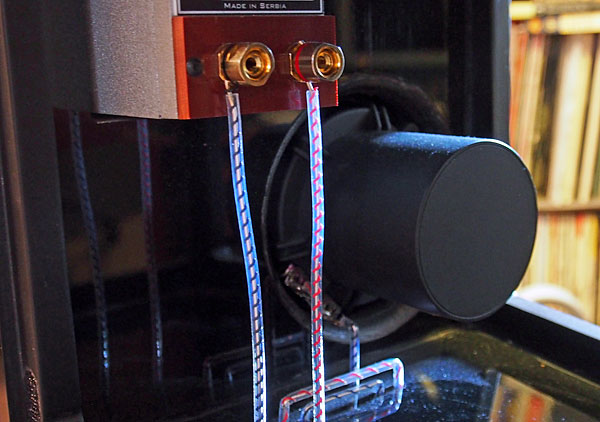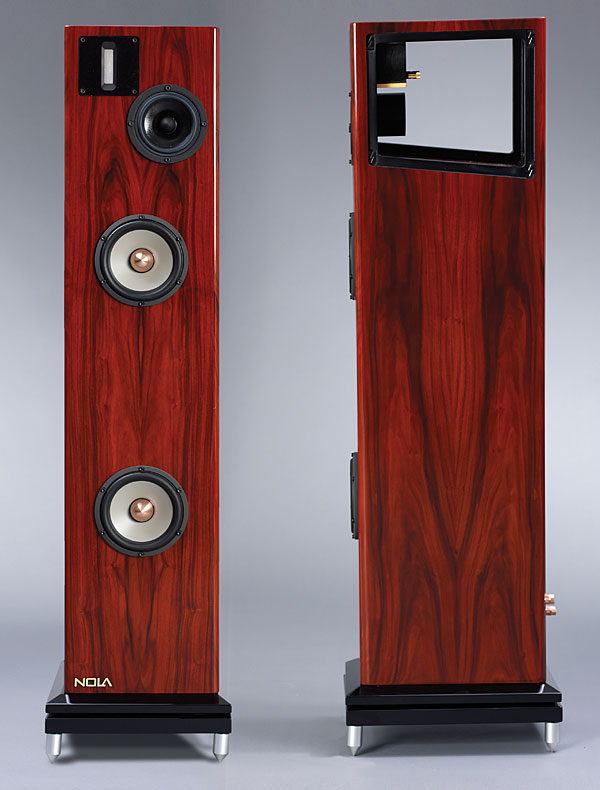| Columns Retired Columns & Blogs |
Looks like the feet can get bent out of shape fairly easily!
Cheers George

I reached for my Editor's Choice (CD, Stereophile STPH016-2), put together more than a decade ago but still an invaluable diagnostic tool. The low-frequency, 1/3-octave warble tones were reproduced with full weight down to the 25Hz band, but, as always with speakers with excellent bass extension, the 32Hz warble tone was boosted by a room mode. The 20Hz warble tone was inaudible at normal listening levels. One oddity was that there was an audible rattle with the 100 and 32Hz warble tones. Some of the hex-head bolts securing the woofers to the baffles on both speakers were loose, so I tightened those, but to no effect. I further investigated using a sinewave generator, and it turned out that the rattle was coming from the ball-bearing–isolated base. At exactly 34Hz, the speaker shook—the rattle was due to the top part of the base sliding on the bearings and hitting the end stops. This resonance was of very high quality factor (Q), so would be unlikely to be excited by music, but it does suggest that this base doesn't provide a sufficiently effective mechanical ground for the Metro Grand's enclosure.
With the half-step–spaced toneburst track on Editor's Choice, the tones didn't speak as cleanly as I wished through the lower midrange, between 128 and 512Hz. Listening to the enclosure panels with a stethoscope, I could hear strong vibrational modes in this region on all surfaces other than the front baffle, as well as a low-level mechanical buzz from inside the speaker. The "lid" over the cabinet's open-baffle section was also very lively. I continued my auditioning with Acoustic Ballasts—canvas bags filled with lead shot—on the lids and a VPI Brick on top of the woofer sections; this silenced the buzzes, but didn't seem to reduce the amplitude of the cabinet vibrations, nor did it affect the frequency-specific shaking from the ball-bearing bases.
Substituting the ARC Reference 75 for the Pass Labs monoblocks resulted in an improvement in midrange tangibility, though the low frequencies lost a little extension. In Saturn, from Holst's The Planets, with Sir Adrian Boult conducting the London Philharmonic (CD, EMI CDM 7 690452), the arpeggiated double-bass tune at the start of the coda didn't speak quite as easily as it had with the solid-state amplifiers, though when it repeats, doubled by organ bass pedals, the Metro Grand References still let me feel the weight of the sound. However, there was a reticence to the Nola's sound—the climactic organ passage at the end of Uranus on this CD never sounded loud enough, especially with the ARC amplifier, even when I turned up the volume. On the plus side, the sound didn't become congested at high levels.
Even so, well-recorded drums generally sounded excellent through the Nolas, with impressive impact and weight. Mark Walker's driving tom-toms concluding "Too Rich for My Blood," from Patricia Barber's Café Blue (DSD rip from LP, Premonition 90760-1), sounded suitably powerful—as did Ginger Baker's toms in Thelonious Monk's "Straight, No Chaser," from the Ginger Baker Trio's Going Back Home (ALAC file ripped from CD, Atlantic 82652-2). More important, the Nola successfully differentiated the sounds of the drums on these recordings from the similarly pitched doubles basses of, respectively, Michael Arnopol and the late Charlie Haden.
Bill Frisell's fine electric guitar playing in "Straight, No Chaser" reminded me that it had been a long since I'd played his East West (ALAC files ripped from CD, Elektra Nonesuch). "A Hard Rain's A-Gonna Fall" starts with seemingly random noodling over a pedal D, from which the melody cautiously emerges. The Metro Grand Reference reproduced Frisell's guitar with excellent midrange clarity, and when it enters on the verse, Viktor Krauss's double bass had excellent weight. However, I kept feeling, as the song relentlessly grew in complexity and loudness through its almost 12 minutes, that Kenny Wollesen's cymbals lacked air. I had to sit upright to get more top-octave energy, but it was still not quite enough.
Alerted to this issue, I began to notice it with other recordings that have more subtle treble registers. I recently picked up a collection of arrangements for two pianos of works by Debussy and Ravel, performed by Vladimir and Vovka Ashkenazy and recorded by my friend Tony Faulkner (CD, Decca 478-1090). I love Ravel's La Valse, but had only ever heard it in its orchestral guise. The two-piano arrangement on this disc was musically convincing, with the Metro Grand References adding weight to the left-hand registers as the music swoops down to the lowest octaves. However, the sound of the pianos lacked air unless, again, I sat bolt upright.

This was with the Nordost Odin speaker cables. Replacing them with my usual Kubala-Sosna Elation! cables seemed to take away more of the high treble. In my usual listening position, my ears are 36" from the floor. Sitting as upright as I could put my ears 41" high, which is still 4" below the center of the ribbon tweeters. I reached again for Editor's Choice and selected the dual-mono pink-noise track. In my usual position, the pink noise sounded smooth but a bit too mellow. As I rose in my seat, more top-octave energy became apparent, though the low treble began to sound slightly hollow. The image of the noise, which should be narrow and centrally placed, was also a little broader than usual.
Looking back through my listening notes, it doesn't appear that I played much rock music during the time the Nola Metro Grand Reference Golds were in my system. I've noted before that audio components tend to dictate the kind of music you play—the Nola's generally polite, rather mellow balance favored jazz and orchestral music over rock, although female singers—such as Patricia Barber on Café Blue—sounded extremely convincing.
Summing Up
I actually enjoyed the Nola Metro Grand Reference Gold speakers. Their polite tonal balance took the edge off of older classical recordings, and as long as I didn't play the music loud, I could enjoy the speaker's positive attributes—the extended, weighty low frequencies, the pristine upper midrange, the rich tonal balance—without being reminded of its lack of clarity in the lower midrange and its subdued top octave.
But what might be minor criticisms in a less-expensive speaker become significant in a model costing $33,000/pair. This is especially the case when you consider that the last two speakers I reviewed and recommended, the Joseph Audio Perspective and Triangle Signature Delta, respectively cost $13,000 and $8000/pair, and overall offered a better-balanced performance than the Metro Grand Reference. Promise unfulfilled, I'm afraid.

Looks like the feet can get bent out of shape fairly easily!
Cheers George

I really appreciate the honesty and clarity of JA's reviews. Having met him a few times at CES, he is a remarkably nice person - and clearly a sound technologist (no pun intended). But this review, although accurate in terms of observed limitations, doesn't fully convey how tremendous these speakers are in day-to-day listening. These, and the Nola Micro Grand Reference, are among the best loudspeakers I've heard to date. It seems that manufacturers have to make choices in terms of how their products ultimately sound, while knowing they may not meet what are normally valid performance standards (vibration, ultimate treble extension, etc.). I have listened at length to the usual suspects, and although I don't have JA's years of experience in this arena, I can say it all comes down to subjective preference and system synergy. Given my own experience, these speakers are simply astonishing in terms of what they convey musically.

Looks like the feet can get bent out of shape fairly easily!
Pretty sure that's a photographic distortion. The review samples had feet that were super-straight.
John Atkinson
Editor, Stereophile

$33,000 per pair sounds expensive for speakers that do not play loud or have good clarity in the midrange. for 1/3 the price one could have a pair of Klipshorns and a small tube amp and you will have both volume and Clarity.

I'm curious. Where is the cutoff for Audacious Audio? Has it changed over time?

Where is the cutoff for Audacious Audio?
Basically, any product with a price significantly higher than that of the typical price for that category qualifies for the "Audacious" label.
John Atkinson
Editor, Stereophile

That's a bit of hyperbole, isn't it? They're quite lovely in person, and I would know, thanks. And to call the IRS "ugly"?? Can't fathom your idea of beauty…
Moving along, Mr. A's review is fascinating, given The Absolute Sound's review of the speakers several years ago, in which they hardly sounded "polite." I don't doubt Mr. A's hearing at all. I suspect a change in drivers from back then. I heard the speakers years ago, and the sonics were different, which I attributed to different equipment. Now? I don't think so. A friend had older Boxers and compared them - in his room - to another friend's newer Boxers. Sound was different, mainly in the treble, which did not expand dynamically on the newer ones. The newer ones sounded less real than the older ones. His dealer thought the same thing, but hey, you sell what you got, right? Something's changed over time. Not that unusual: the Pipedreams are also said to have sounded different from one pair to the next, as noted in TAS. Maybe it's a capacitor, who knows? But those Boxers? No question they were more cousins that identical twins. Heard that about the next speaker up in the line, too. I wonder why a company does that?